Winner of the 2023 WLA Awards – Merit Award in the Built Large Landscape Design category
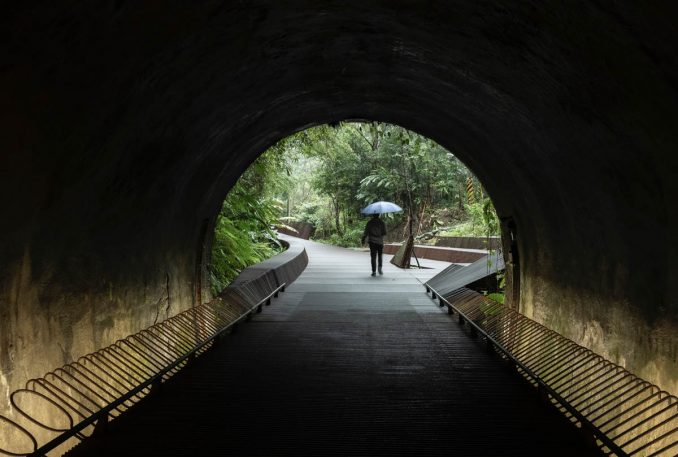
THE SITE
The Dark Line is located in northeast Taiwan, a tropical mountainous region. In the 1920’, a colossal railway project was undertaken to transport coal and agricultural goods to the ports of Keelung and Taipei. In the 1980’, this first railway line was replaced and abandoned.
THE QUESTION
Tourism became the area’s main asset after the coal mines’ closure; New Taipei City initiated a program of cultural hiking routes, linking historical trails, abandoned industrial sites, and old railway infrastructure.
In 2018, a competition was launched to build the 3km section between Mudan and Sandiaoling, which includes two historic railway tunnels and a connection to be invented to replace a bridge that has been washed away.
OUR POSITION
We take a clear option: preserve the historical AND ecological depth of the post-industrial landscape.
The fact that a structure that required such considerable investment is left to vegetation and bats, with its mouth full of silt and rocks, expresses the power of the changes in History. The passage of time has produced ecological, atmospheric, acoustic, chromatic and luminous variations along this route, which are the core of our proposal.
THE INTERVENTION
Despite the challenging environments and the heavy interventions necessary to open this route to the public. The Dark Line’s design objective was to reuse the old structures and let the landscape speak for itself.
A SINGLE MATERIAL
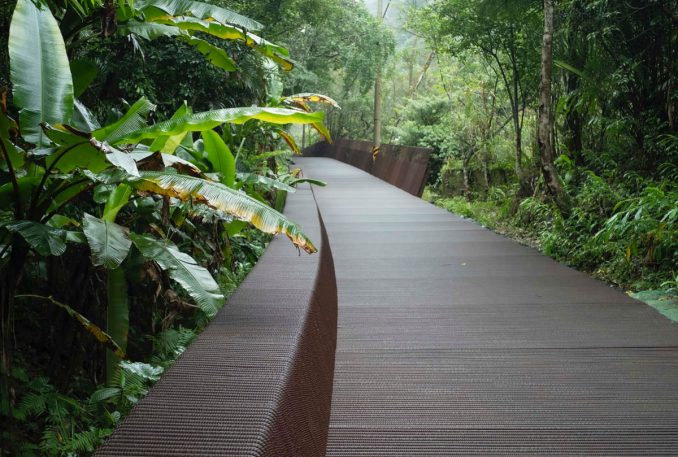
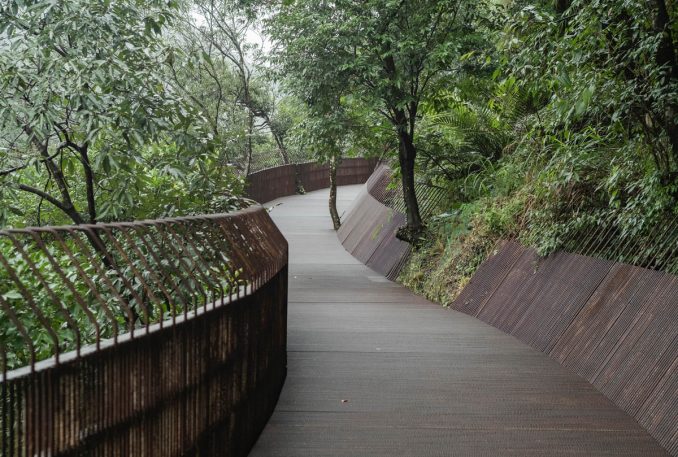
The choice was made to use a single material, able to make us forget its presence but also to evoke the two major phenomena that impacted the site over a century:
– steel is building a new “railway”,
– the gaps left between the steel bars allow the powerful action of tropical nature to be seen and continued
Some 50,000 corrugated steel bars, repeated ad infinitum, all parallel, let us see through the gaps, under our feet, the rocks and silt in the tunnels and the luxuriant vegetation in the gorges.
They bend to create railings, benches, bicycle racks, small amphitheaters, kilometer markers and protective vaults in the most fragile sections of the tunnel.
A CONSTRUCTION SYSTEM
To adapt to the complex configuration of the site, the project takes advantage of the specific production conditions of the construction industry in Taiwan. The local industry and crafts were capable of both mass production in workshops, and “haute couture” adaptation on site.
The Dark Line Tunnels
The track layout is based on the geometrical properties of a railway track, always with tangential junctions. It allowed the use of a modular decking system produced in the workshop and assembled on-site.
The challenge was to install the decking without “touching” the existing rock, silt soil and water currents:
- We enter the tunnel as if on tiptoe, on isolated foundation blocks.
- Metal beams build new rails above the existing ground left untouched. They allow the circulation of a custom-built transport and lifting shuttle.
They also serve as support for the panels of the decking modules prepared in the workshop.
Once the elevated path has been created, the manual installations can be carried out easily.
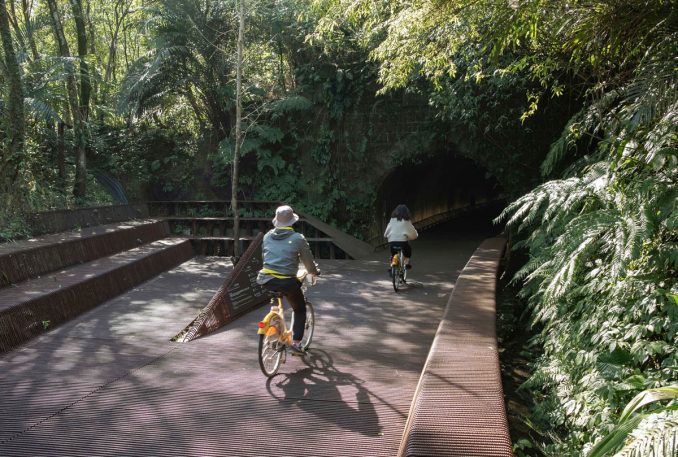
For the corbelled footbridge,
We geometrically interpreted the irregularities of the cliff to design a single curved module. The very large radius of curvature allows the course to follow the uneven and random profile of the topography as closely as possible without departing from a regulated route.
An implementation that does not touch the vertical wall and its vegetation.
- A series of concrete blocks whose rhythm is the same as the religiously preserved trees
- The metal brackets are craned from the upper road.
- The planking frames, prefabricated in the workshop according to rigorous geometry, are laid in one direction and then in the other to create the curves.
A SUCCESSION OF CONTRASTING ATMOSPHERES
The Eastern Entrance
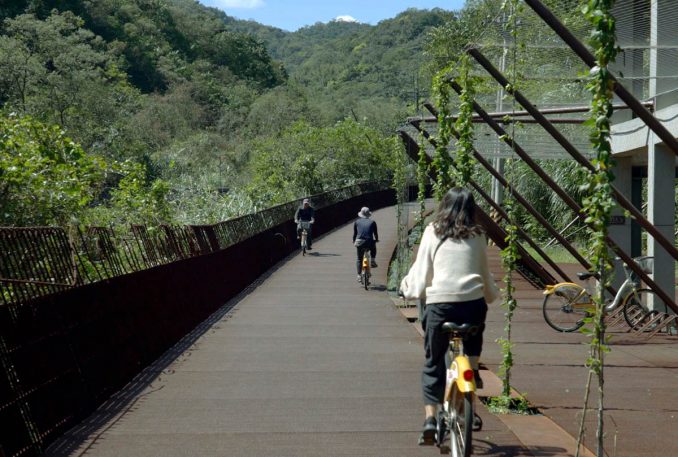
At the start of the route, the decking raises to leave the old ground intact. It lets trees and grasses emerge through it. The atmosphere here is one of birdsong, chirping insects, rustling leaves, and flowing water sounds.
The Sandiaoling Tunnel
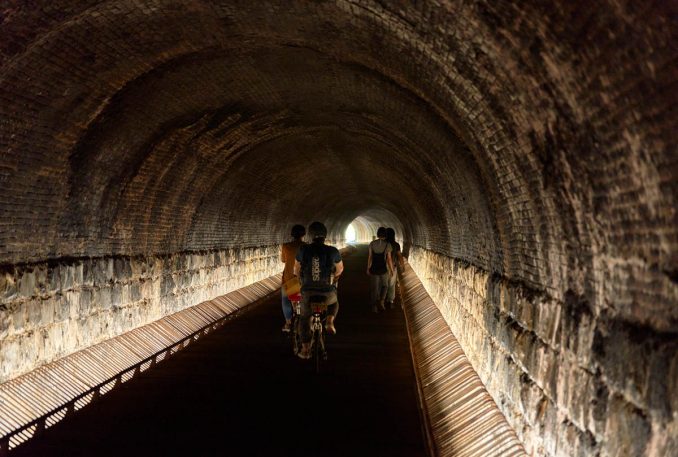
We now enter the cavernous darkness of the tunnel.
Artificial lighting is minimal and bathes the foot of the vault and the floor.
It guides the visitors’ steps and reveals, under the planking, the variations of the original ground: rocks, meanders of water infiltration, colored silts, and ballast. The invisible light source spares the intrados, where colonies of bats cling in a semi-darkness.
The darkness of the walls, covered with smoke residues, sometimes gives way to the wet, glittering and multicolored surfaces of limestone concretions in formation.
Between the Two Tunnels
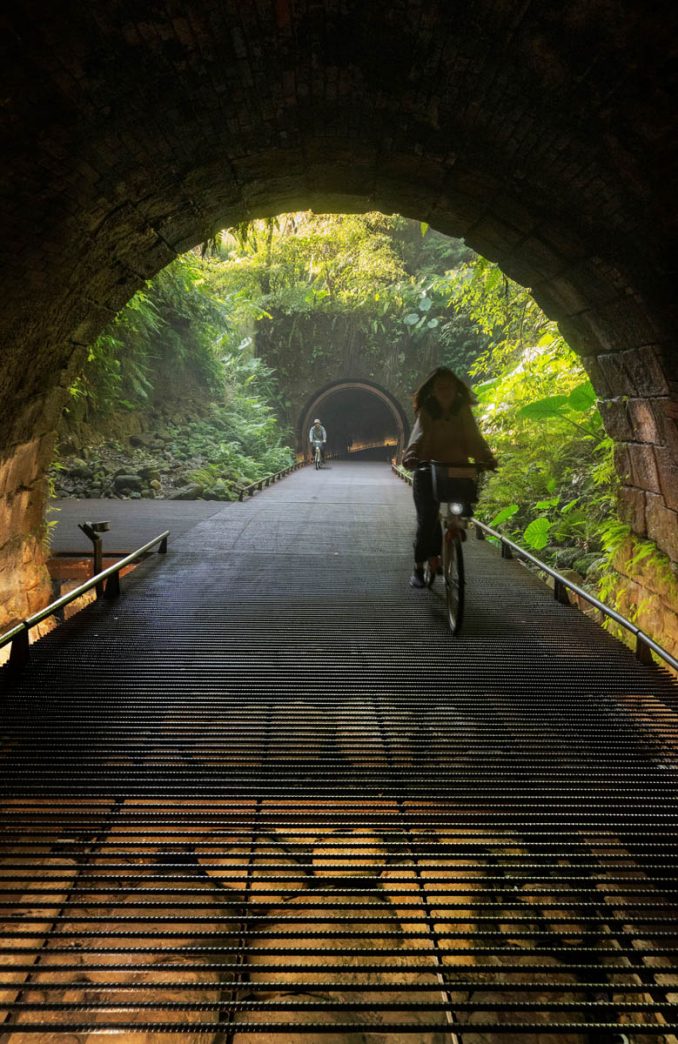
At the end of this long underground gallery, we arrive at the bottom of a high vertical shaft of natural light, a gap towards the sky left by the bed of an ancient torrent.
The sun’s rays filter through the layers of foliage of the cliffs and produce, in contact with the vapors exhaling from the tunnel, an unreal atmosphere of a fantastic tale.
The Sanzhuazi Tunnel
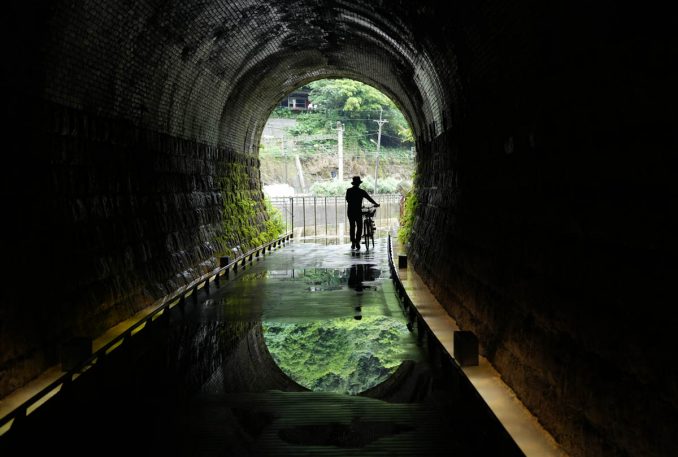
After this stop, we enter the second tunnel, which after a wide curve, opens onto the void of the gorge.
There, a water mirror lets the luminosity of the opposite bank penetrate under the vault and tells us about the void left by the old bridge that has disappeared.
Fed by natural run-off, this basin-haha extends over the cliff in a triangular overhang, pouring water into a waterfall. The visitor’s silhouette remains suspended between its reflection and the vegetal background of the opposite bank.
The Footbridge
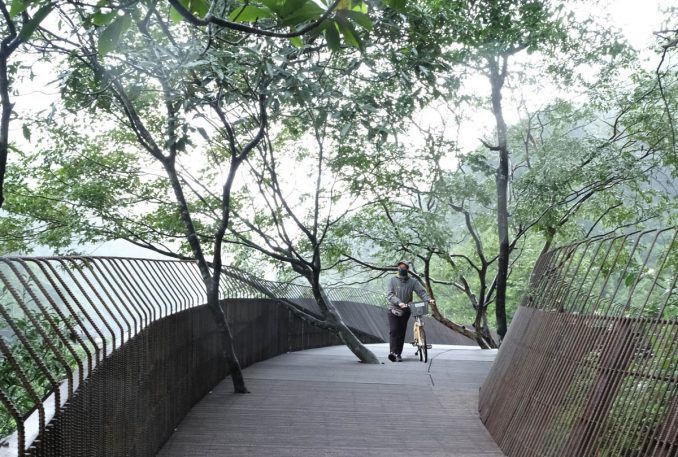
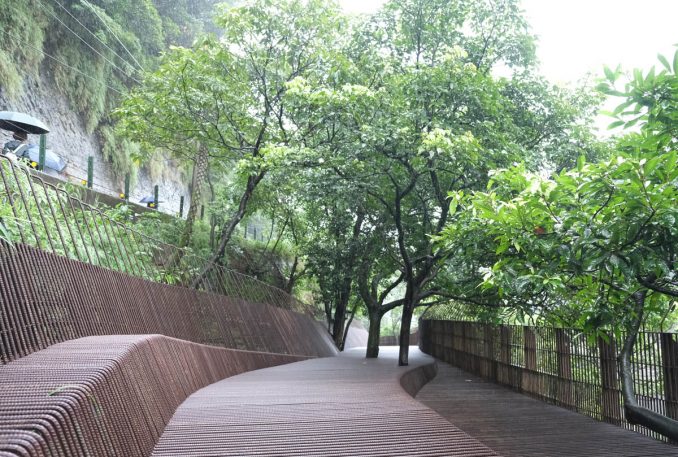
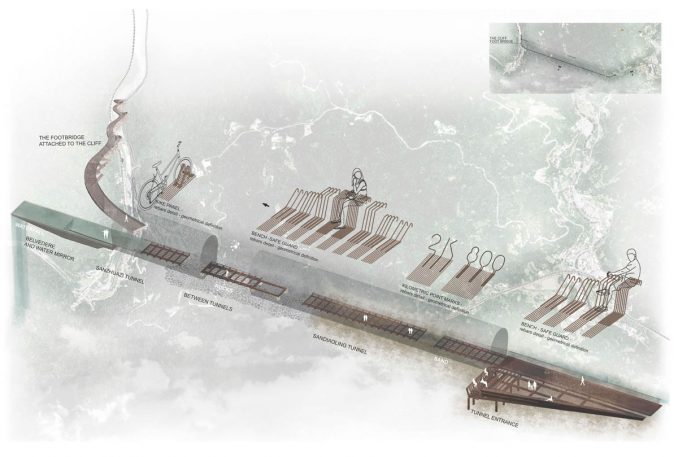
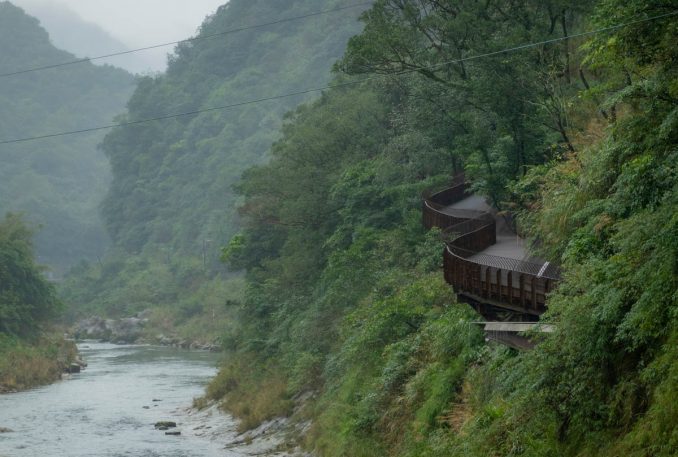
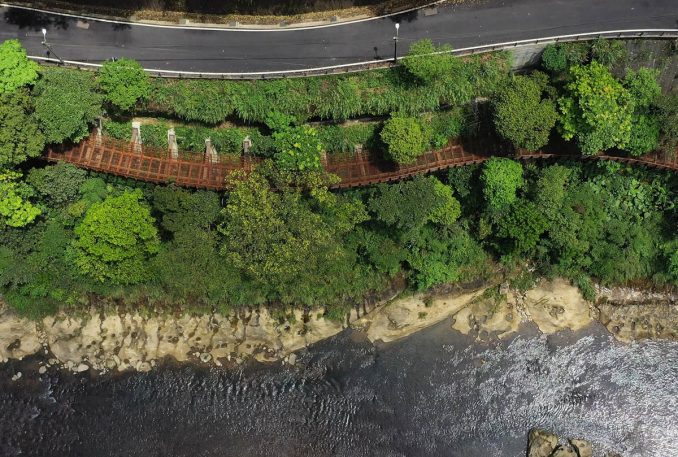
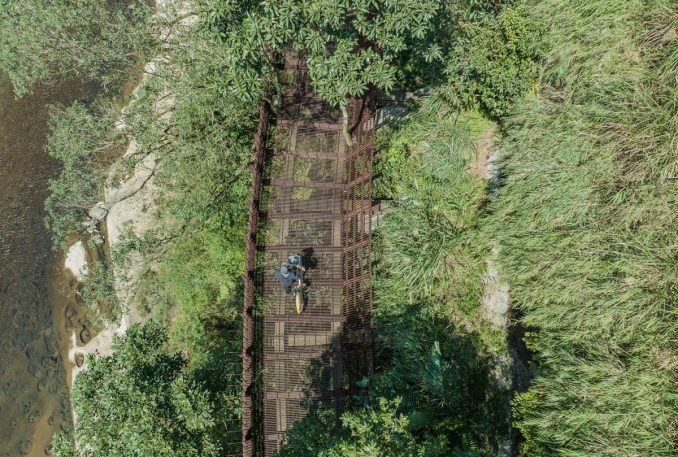
Deviating to the side, the footbridge corbelled to the vertical wall of the gorge continues the journey. Like a long balcony, following as close as possible to the sinuosities of the cliff.
We now discover, in full light, the distant landscape. While in the tunnels, we explore the depth of the ground in semi-darkness; here, we walk on the canopy of the luxuriant vegetation between the highest trees, emerging under our steps.
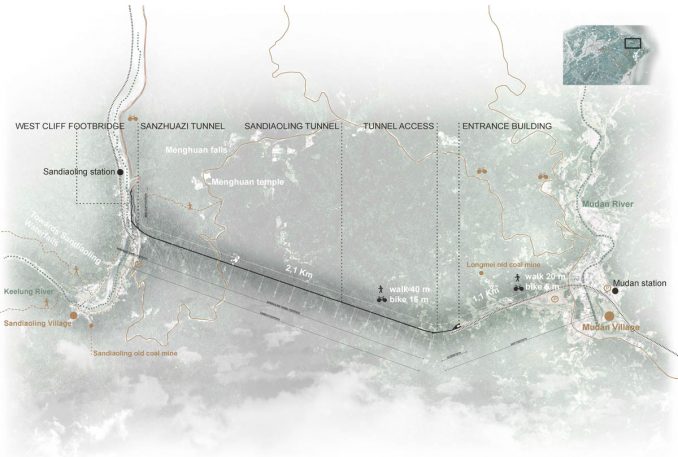
The Dark Line | MICHELE&MIQUEL ARCHITECTURE&PAYSAGE + dA VISION DESIGNa
Client: Public Works Department, New Taipei City Government
Designer and project manager:
MICHELE&MIQUEL Michèle ORLIAC & Miquel Batlle architects and landscape architects
dA VISION DESIGN Chung-Hsun Wu landscape architect
Internal Team:
MICHELE&MIQUEL: Jerôme Lanche, Maria Fandiño, Giovana Bartholeschi, Jean Orliac, Grégoire Orliac, Denis Wanders, Adrià Fenoll
dA VISION DESIGN: Jerry Chang, Ming-Hsien Liu, Lilian Chang
External Collaborators:
Lighting designer : ARTEC 3 STUDIO
Structural engineer: YU SHENG engineering consultants, elements structural engineering associates
Géotechnical engineer: GEOLITHE engineering
Tunnel structural consultant : SINOTECH engineering consultants INC
Electrical engineer: YUAN DIAN Engineering Consultant
Building Company: DAO TIAN Construction Co., Ltd
Photos crédits : Yu-Jui Lu, mICHELE&mIQUEL
Images credits: mICHELE&mIQUEL
